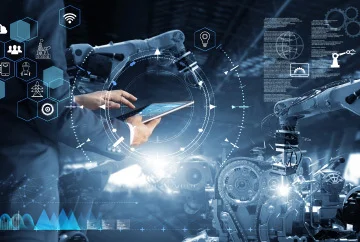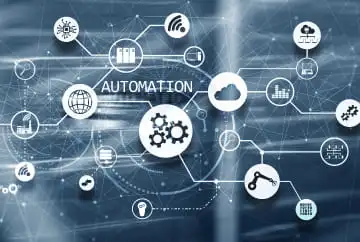#1. Generative AI beyond the hype
When the world got its first impressions of Gen AI through OpenAI’s ChatGPT in 2023, the technology was heralded as a milestone as significant as the Internet in terms of its economic potential. Recent estimates suggest that it could add 7% to the global GDP1, and drive 15-40% in productivity gains.2
In 2024, investments in Gen AI will start paying off. More complex use cases of Gen AI are already in the pipeline. Multimodal models, where Gen AI algorithms work across multiple types of data (like text, images, video, or sound), are bringing advanced disease diagnostics, multimedia AI search, and machine failure prediction within the ambit of the technology.
What’s more, the entry barrier to the technology stands significantly reduced. Providers are making targeted use cases available to enterprises through the cloud. These factors will democratize access to tried and tested Gen AI capabilities, including, but not limited to employee productivity gains, and improved operational efficiency.
The widespread adoption of Gen AI is also evident in rising concerns about its explainability and regulatory interest in the technology. Explainability is a key concern in applications like code generation and completion, where the explainability of the output impacts user choices and software design considerations. In other applications, explainability is becoming essential to ensure fairness – especially in those scenarios where Gen AI models interact with customers.
Ultimately, as enterprises adopt this technology, mitigating privacy, security, and ethical risks will be essential. This can be ensured by leveraging governance frameworks that implement these guardrails to mitigate risk early on in the adoption journey.
#2. DeFi to find real-world applications
Blockchain technology has been evolving for over a decade and its applications range from cryptocurrency and supply chain to healthcare and insurance. In particular, Decentralized Finance (DeFi) and asset tokenization are revolutionizing finance. DeFi’s potential in reshaping global financial systems has been speculated for years, and these speculations are turning into a reality rapidly.
The tokenization of financial assets and instruments, like treasuries, real estate, bonds, carbon credits, and stocks holds the most promise here, as it can improve liquidity, reduce transaction costs, and make Centralized Finance (CeFi) systems more efficient.
In this light, layer 2 solutions are becoming increasingly important. As the computing costs and time taken to complete a transaction on layer 1 solutions increase in high-utility blockchains like Ethereum, layer 2 solutions are making such blockchains cheaper and faster. This sharding can help CeFi players like brokers or exchanges solve challenges surrounding liquidity traps with Hybrid Finance (HyFi) systems.
Regulations will address the growth challenges of DeFi
As DeFi platforms grow in size and scope, they are also attracting increased regulatory scrutiny. The Bank for International Settlements suggests that 19 jurisdictions have proposed policies to address financial, infrastructural, and distribution risks underpinning decentralized ledger operations.3 Moving ahead, advanced regulatory policies, like smart contract audits will help mitigate financial crime and raise standards across the DeFi ecosystem.
#3. The rise of intelligent apps
In an increasingly digital economy, the market for intelligent apps is growing rapidly, estimated at 32% annually.4 This is not surprising, as AI capabilities are finally finding their way into mobile, web, and SaaS apps. Embedded intelligence can simplify processes, and enhance the outcomes of workflows. However, embedded intelligence is also becoming contextual – meaning, intelligent apps are becoming industry-specific.
These industry-specific intelligent apps are driving the most valuable outcomes in the respective industries – tailored recommendations in Media and Entertainment or enhanced demand sensing and planning in manufacturing. As most organizations have already adopted the cloud, achieving targeted outcomes through intelligent apps is now a reality. For example, a manufacturer can now achieve proof of quality for its products by integrating a blockchain and AI-powered intelligent quality app into its ERP and MES system. Similarly, premium-label businesses can serialize their products to eliminate counterfeit items with intelligent apps, and an oil drilling company could enable round-the-clock visibility into its rigs by building mobile apps that communicate with their SaaS monitoring solution.
Time to go beyond conversational interfaces
However, the very definition of intelligence is about to take a turn in the context of intelligent apps. Intelligence in the present time will mean intent recognition, hyper-personalization, and context awareness going beyond just a conversational interface.
While Gen AI will make conversational interfaces smarter, intelligent apps will be powered by multiple types of AI algorithms, each working to enhance the user experience uniquely.
#4. Platform engineering takes the centerstage
With the growing value of digital solutions, developer experience and productivity is becoming a key focus area for digital-native organizations. Platform engineering evolved in response to this need, and in 2024, it will become an extension of the DevOps function. As developers navigate more complex software architectures, developer platforms will deliver new features that reduce duplication of effort across the engineering workforce – like spinning new environments upon request, setting up namespaces, updating configurations, and so on.
This will accelerate development at scale and standardize the tooling in use across multiple teams. Moreover, IDPs (Internal Developer Platforms) will become an essential strategy for fostering a DevOps culture within the organization with self-serve capabilities and automation. In turn, DevOps teams will find themselves running and managing the underlying infrastructure for their IDPs and evolving their capabilities in response to user needs – thus expanding service catalogs to support the developer workforce.
How AI is evolving platform engineering
In the context of platform engineering, AI will perform a dual function. It will not only help platform teams build more compelling IDPs but also feature prominently in the capabilities of the platform itself. This means that AI capabilities will be integrated to automate tasks like managing and merging code changes and explaining complex Kubernetes workflows to less-experienced operators. Gen AI applications could help developers spin configurations, discover resources faster, or answer questions about products or code vulnerabilities. Ultimately, development will be accelerated, release velocity and frequency will go up, and developer productivity will get a significant boost.
#5. Vertical clouds to empower differentiation
Cloud adoption has already enabled enterprises to achieve digitization at scale while retiring their clunky on-prem deployments. While industry-specific cloud products have been on offer for the last few years, their adoption has remained limited to a few large-scale organizations. In 2024, this is set to change, with many more organizations in the process of adopting vertical cloud solutions and entering the pilot phases.
With vertical clouds, industry-specific capabilities will become available to organizations, eliminating the need to build these capabilities from scratch. For instance, predictive maintenance, supply chain digitization, digital twin, and ecommerce capabilities will become accessible for all manufacturers, leveling the playing field between small and large organizations. Similarly, healthcare organizations will find data interoperability capabilities embedded into their industry cloud modules, saving custom development efforts, and making connected care delivery a reality.
An important outcome of industry cloud capabilities is that digital transformation outcomes will be attainable with assured success and reduce the wastage that goes into prototyping and scaling successful use cases. Moreover, they will shift the focus to differentiating the business with a select few digital capabilities in an increasingly competitive landscape.
#6. 5G and Edge to bring compute closer to action
While 5G coverage has been steadily rising globally, the technology has not been exploited beyond the fast connectivity it offers to users. This is set to change in 2024, as more and more businesses connect their edge computing deployments with the public cloud. One of the key breakthroughs will arrive in the form of a continuous network and compute fabric, driven by the integration of 5G wireless networks with powerful compute capabilities at edge sites. A continuum of fast networking will eliminate the latency and bandwidth differences that currently characterize Wireless LAN and mobile networks.
With this network continuum and cloud-edge integration, enterprises will be able to bring compute closer to the point of action – be it M2M applications, or mobile experiences for end-users. Using 5G and Edge computing in tandem, businesses will be able to deliver rich, latency-sensitive, and computationally expensive use cases on less capable devices. For example, AI models will be trained in the public cloud, and deployed at the edge to deliver intelligent decisioning to mobile devices and Industrial IoT (IIoT) networks. Likewise, the fabric of connected devices will expand and grow denser. All these forces will come together to complete the Industry 4.0 vision that organizations have been chasing since the last decade.
These possibilities spell exciting growth opportunities in a market that has been termed 5G Edge Computing and is expanding at a rate of 51% annually.5 5G Edge Computing will be exploited to deliver innovative use cases, ranging from smart home platforms to intelligent shop floor solutions and AI-powered AR experiences – unlocking new value streams for businesses.



